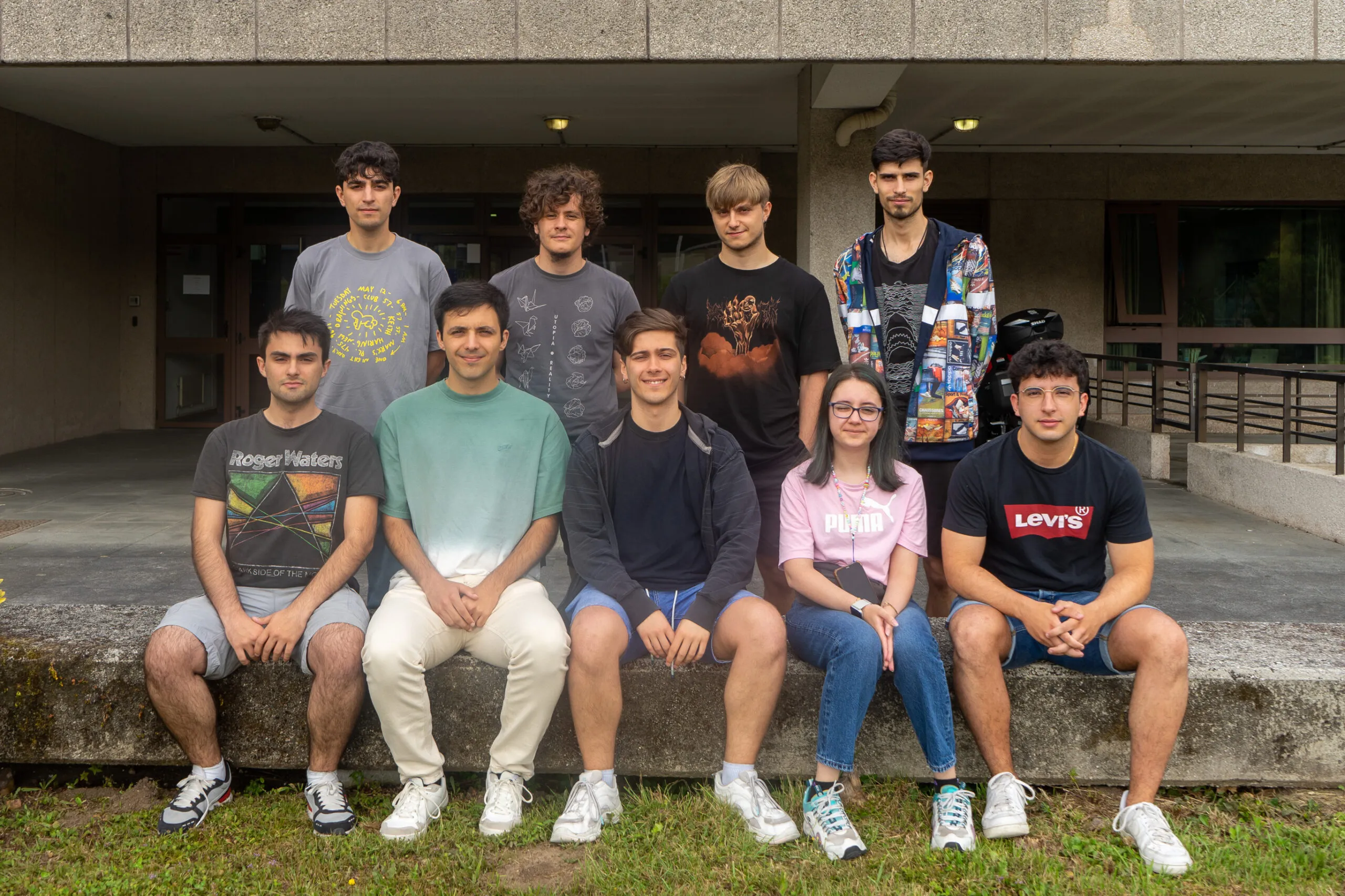Un mes aprendendo no IGFAE: así foi a experiencia do alumnado das Bolsas de Verán



10.06.2019

O experto en ondas gravitacionaiss Bernard Schutz foi un dos relatores convidados ao 9th Iberian Gravitational Wave Meeting, un congreso organizado a semana pasada polo Instituto Galego de Física de Altas Enerxías (IGFAE) en Santiago de Compostela. Ademais de compartir coa comunidade investigadora os avances científicos e tecnolóxicos desta novo xeito de “escoitar” o Universo, deu unha charla divulgativa na USC sobre o papel crucial destas oscilacións espazo-temporais, preditas por Einstein en 1916, na evolución humana.
Por Elena Mora
“A primeira detección de ondas gravitacionais en 2015 foi fantástica; porén, a ocorrida o 17 de agosto de 2017 tivo consecuencias e implicacións moito maiores”, afirma Bernard Schutz, catedrático na Universidade de Cardiff e cunha traxectoria de máis de 40 anos dedicada ao estudo destas vibracións. “Ao observar a fusión desas dúas estrelas de neutróns comprendemos que a metade dos elementos da táboa periódica, os máis pesados, prodúcense nese tipo de explosións”. Foi un achado excepcional que os medios de comunicación internacionais recolleron avidamente, aínda que os titulares destacaron case en exclusiva as evidencias definitivas da orixe dun dos nosos metais máis prezados: o ouro.
Aínda que xa se sabía que as estrelas son os fornos que fabrican no seu interior os elementos químicos mediante a nucleosíntesis —proceso polo que o hidróxeno se fusiona en átomos máis pesados- non había suficientes probas de como se xeraban os que están máis aló do ferro. Necesítase máis enerxía para que os núcleos atómicos fusiónense e aquí é onde entran en xogo as estrelas de neutróns: cunhas 1,5 masas solares e o diámetro da cidade de Santiago, son tan compactas e densas que a enerxía emitida cando chocan, tras danzar en espiral obrigadas polas ondas gravitacionais, é descomunal. Froito desta explosión nacen dous elementos que pasaron no seu momento desapercibidos para o gran público, aínda que non para Schutz: o uranio e o torio. Desde hai pouco, xunto co seu colega Tsvi Piran da Universidade Hebrea de Xerusalén, estuda o papel destes isótopos na evolución da vida na Terra. Como explicou ante un público inicialmente escéptico na Facultade de Física da USC o pasado luns, o uranio 238 e o torio 232 manteñen a Terra quente mediante a enerxía que emiten ao desintegrarse; e esta calor, tras unha longa sucesión de eventos, fixo posible que hoxe gocemos dunha intelixencia máis desenvolvida que nos trouxo ata aquí.
Uranio e torio, fontes de calor terrestre
A Terra formouse a partir dun disco de po e gas que colapsou pola súa propia gravidade fai uns 4.500 millóns de anos. Esa nube, da que nacerían tamén o resto dos corpos do Sistema Solar, estaba composta por elementos químicos expulsados por xeracións de estrelas anteriores ao Sol, entre os cales se atopa o uranio e o torio que existe hoxe na natureza. Distribuídos polo interior terrestre, liberan enerxía ao ir desintegrándose paulatinamente, axudando a manter o núcleo externo da Terra como ferro líquido. Isto á súa vez permítenos ter un campo magnético que nos protexe do vento solar e, en última instancia, mantén a atmosfera que posibilitou o desenvolvemento da vida. Marte, pola contra, aínda compartindo moitas das características do noso planeta, é inhabitable porque perdeu o seu campo magnético.
“Á parte da existencia da magnetosfera, o uranio e o torio tamén causan o movemento das placas tectónicas”. Schutz sostén “que a calor liberada produce a convección do manto terrestre, que é rochoso, e que durante millóns de anos provoca o movemento dos continentes”. E prosegue: “suceden dous procesos crave: o primeiro é que se recicla o carbono. O dióxido de carbono queda atrapado nas cunchas de animais enterrados na roca calcaria do chan que, mediante o movemento de subdución, emerxe de novo a través dos volcáns, mantendo o CO2 atmosférico que necesitan as plantas para facer a fotosíntese e nós para respirar”.
A segunda consecuencia do movemento continental é que obrigou aos animais a evolucionar de xeito diferente. “Aquí é onde atopamos o maior contraste: mentres que nos océanos os animais experimentaron retos máis pequenos na súa contorna, nos continentes o clima podía cambiar drasticamente, e había outras ameazas como volcáns e terremotos que obrigaban aos animais para adaptarse e evolucionar”. Prudente, pero convencido, Schutz conclúe que “este é o motivo polo que atopamos unha intelixencia social máis evolucionada en animais terrestres. A natureza desafiounos moito máis a nós que aos animais que evolucionaron exclusivamente nos océanos”.
Gravidade pura e física fundamental
Esta viaxe retrospectiva cara ás nosas orixes comezou coas ondas gravitacionais producidas por dúas estrelas de neutróns e observadas polos interferómetros LIGO e Virgo en 2017. A pesar do habitual destas deteccións na actualidade, non foi ata 2015 cando se atoparon por primeira vez, poñendo fin a un periplo científico e tecnolóxico que remóntase a 1916 cando Einstein predíxoas na súa Relatividade Xeral. Schutz recoñece que durante a súa carreira houbo períodos complicados, pero nunca dubidou acerca da posibilidade de detectalas. “Levou tempo e financiamento desenvolver a tecnoloxía”, confesa. De feito, uns dez anos tras finalizar a súa tese doutoral dirixida por Kip Thorne, premio Nobel de Física en 2017 polo descubrimento destas, pedíuselle que contribuíse á proposta dun novo detector en Escocia. “Como físico teórico, tiven que convencer aos organismos de financiamento de por que debiamos construílo e iso seduciume por completo. As ondas gravitacionales son gravidade pura e física fundamental e tráennos información do que ocorre no Universo. Por iso son tan fascinantes”, afirma entusiasmado.
O seu interese por elas levoulle a publicar un artigo en Nature en 1986 polo que foi recoñecido coa Medalla Eddington o pasado mes de xaneiro. “Mostrei como poderían usarse as ondas gravitacionais para coñecer a velocidade de expansión do Universo. En Astronomía é case imposible determinar distancias porque, por exemplo, observas unha estrela e non sabes se o seu brillo débese a que está preto ou porque, aínda que está máis lonxe, é intrinsecamente máis luminosa. Grazas ás ondas gravitacionaia poderiamos saber cuán lonxe está o sistema que as produce. Se podemos medir a velocidade coa que o sistema se está afastando de nós, por exemplo, medindo o desprazamento oo vermello do espectro da galaxia onde aconteceu o evento, podemos medir o que denominamos a constante de Hubble- Lemàitre, o cociente entre a velocidade e distancia que rexe a expansión do Universo. Mesmo hoxe en día, os astrónomos non se poñen de acordo con ese valor así que esperamos poder axudar a resolver esta controversia”.
Mirar ao futuro para coñecer as orixes
Traballos como os de Schutz utilizaron as primeiras deteccións de LIGO e Virgo, que son só o comezo da nosa procura para escoitar e comprender a natureza das ondas gravitacionais. Mirando cara ao futuro, xa hai plans para detectores terrestres dez veces máis grandes que os actuais, ademais de para un no espazo: a misión LISA (Laser Interferometer Space Antenna) da Axencia Espacial Europea (ESA), que observará ondas en rangos de frecuencia onde LIGO e Virgo non son sensibles. “No espazo podemos evitar o ruído gravitacional da Terra e construír un detector tan grande como queiramos para atopar as ondas máis débiles”, afirma Schutz, involucrado no deseño desta misión. Programado para o seu lanzamento en 2034, LISA consistirá en tres naves separadas 2,5 millóns de km formando un triángulo que segue unha órbita heliocéntrica a 50 millóns de km da Terra. A súa sensibilidade será óptima a uns 10-3 Hz, unha frecuencia na cal o Universo é rico en ondas gravitacionais. “LISA estará case desbordado de sinais, e a nosa preocupación será separar os sinais superpostos en lugar de atopalos baixo o ruído do detector”. LISA permitirá dar ese salto de xigante necesario para seguir indagando nas nosas orixes ao poder asomarnos xusto cando as primeiras estrelas e buratos negros primordiais comezaron a formarse. “Cando os observamos tan atrás no tempo, estaremos a desentrañar aínda máis a historia das orixes dos seres humanos”.